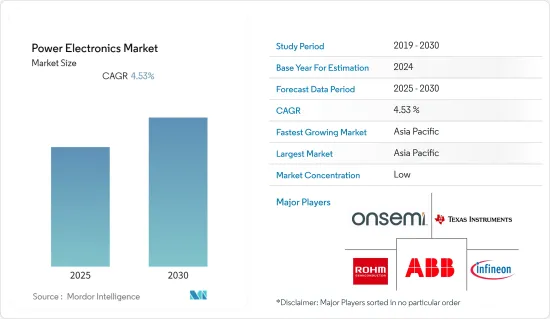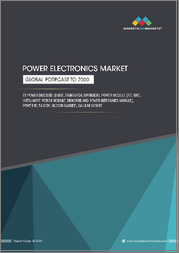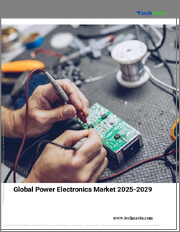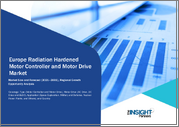
|
시장보고서
상품코드
1687863
파워 일렉트로닉스 시장 : 시장 점유율 분석, 산업 동향 및 통계, 성장 예측(2025-2030년)Power Electronics - Market Share Analysis, Industry Trends & Statistics, Growth Forecasts (2025 - 2030) |
||||||
파워 일렉트로닉스 시장은 예측 기간 동안 CAGR 4.53%를 기록할 전망

주요 하이라이트
- 주목해야 할 것은 전기 에너지의 소비가 늘어나고 있는 것이며, 전기에 의한 용도가 계속 늘어나고 있습니다. 총 에너지 소비의 60% 이상이 전기로 변환되어 사용될 것으로 예상되며, 전기 에너지는 가능한 한 효율적으로 생산, 분배, 사용되어야 합니다. 또한 새로운 기후 변화도 미래의 지속가능한 해결책을 찾을 것을 주장하고 있습니다. 이러한 진화하는 상황에서 미래 문제의 일부를 해결하는 데 필수적인 역할을 할 것으로 보이는 2개의 주요 기술에는 기존의 화석(과 단기) 기반 에너지원에서 신재생 에너지원으로의 전력 생산 변화 및 송배전, 발전, 최종 사용자 용도에서의 고효율 파워 일렉트로닉스의 이용이 포함되어 파워 일렉트로닉스의 역할을 견인하고 있습니다.
- 파워 일렉트로닉스 산업은 수많은 동향에 따라 끊임없이 변화하는 역동적인 환경에 있습니다. 파워 일렉트로닉스 기기 및 시스템은 발전소에서 송전망 전체에 이르기까지 전력 공급망 곳곳에 존재하기 때문에 이들에게 영향을 미치는 요인은 다양합니다. 전기를 소비하는 아이템에도. 모든 것이 전혀 다른 환경이며 다른 영향을 받고 있습니다.
- 에너지 소비 감소는 에너지 산업에 영향을 미치는 큰 동향 중 하나이며, 파워 일렉트로닉스는 부하 요구에 따라 전원에서 부하로의 전기 에너지 흐름을 정확하게 제어하는 중요한 기술로 부상하고 있습니다. 이와 같이, 파워 일렉트로닉스는, 전원, 에너지의 트랜스미션과 배전으로부터, 산업, 수송 시스템, 가정이나 오피스의 전자 제품에 있어서의 다종다양한 용도에 이르기까지, 전력 공급 인프라 전체의 신뢰성과 안정성을 담당하고 있습니다.
- 예를 들어, 첨단 파워 일렉트로닉스는 주전원이나 배터리 전압에서 전자 기기에 이용되는 전압으로 변환할 때의 에너지 손실을 약 50% 삭감할 수 있습니다. 그러나 파워 일렉트로닉스의 중요성은 매우 높음에도 불구하고 현대 산업 사회에서 파워 일렉트로닉스의 역할에 대해서는 정보통인 일반 시민들조차 더 인식할 필요가 있습니다.
- 또한 팬데믹은 IoT 도입을 가속화하고 시장에 긍정적인 영향을 미쳤습니다. 예를 들어 세계 이동위성 공급업체인 임마샛의 최근 조사에 따르면 산업용 사물인터넷(IoT)을 채택하는 기업의 성숙도는 코로나19 팬데믹이 시작된 이후 급속히 높아지고 있습니다.
파워 일렉트로닉스 시장 동향
전자 분야에서 고에너지 절전 장치 수요 증가가 시장 성장의 원동력이 될 전망
- 무정전 전원장치(UPS), 서버전원장치, 전력변환기, 모터구동장치 등의 산업용 기기는 세계 전력의 대부분을 소비하고 있습니다. 따라서 산업용 전원의 효율이 향상되면 기업의 운영 비용을 대폭 절감할 수 있습니다. 더 큰 전력 밀도와 더 뛰어난 열 성능으로 인해 고효율 전원 장치에 대한 수요는 기하급수적으로 증가하고 있습니다.
- 현재 파워 반도체의 가장 일반적인 용도 중 하나는 무정전 전원 공급 장치입니다. 이는 일반적으로 컴퓨터, 데이터센터, 통신 장비 및 기타 전기 장비와 같은 예기치 않은 정전이 인명 사고, 사망 사고, 심각한 비즈니스 손실, 데이터 중단 및 손실로 이어질 수 있는 하드웨어를 보호하는 데 사용됩니다. 무정전 전원 공급 장치는 일반적으로 배터리와 IGBT(절연 게이트 바이폴라 트랜지스터)를 사용하는 인버터를 포함합니다.
- 고효율 전원 공급 장치에 대한 요구는 빠르게 증가하고 있습니다. 이 확대에 박차를 가하는 원인은 몇 가지 있습니다. 첫째는 에너지를 효율적으로 현명하게 사용하는 것의 중요성에 대한 세계의 의식 증가입니다. 전력을 제어하는 파워 반도체는 세계 사회의 이산화탄소 배출량 감축에 공헌하는 키 디바이스로서, 용도가 확대되고 수요가 높아지고 있습니다.
- 전동 모터 드라이브는 모든 산업에서 중요한 요소 중 하나입니다. 펌프, 팬, 벨트 컨베이어를 구동하고, 현수차와 엘리베이터를 움직여 압축 공기와 냉동을 생성하는 데에도 사용됩니다. 전기 구동 장치는 널리 보급되어 산업에서 사용되는 전력의 대부분을 차지합니다.
- 효율적인 파워 반도체를 사용하면 효과적이고 신뢰할 수 있는 다차원 로봇을 설계할 수 있습니다. 따라서 산업용 로봇의 설치가 증가하고 시장 전망이 밝습니다. 국제로봇연맹(IFR)에 따르면 세계 로봇 설치 대수는 전년에 크게 회복되어 로봇산업에 있어서 과거 최고의 해가 되었습니다. 자동화에 대한 지속적인 동향과 지속적인 혁신으로 수요는 산업 전반에 걸쳐 높은 수준에 도달하고 있습니다.
아시아태평양 급성장 전망
- 아시아태평양은 전년 파워 일렉트로닉스 시장을 석권하고 예측 기간 동안에도 크게 성장하고 계속 석권할 것으로 예상됩니다. 아시아태평양의 소비자용 전자기기, 자동차, 전기통신 및 산업 용도에 있어서 유리한 기회가 시장 점유율의 크기와 지역 성장의 요인이 되고 있습니다.
- 아시아태평양은 현재 세계의 반도체 시장을 독점하고 있으며, 또한 정부의 시책에 지지되고 있기 때문에 시장 조사 결과 시장을 독점할 것으로 예상되고 있습니다. SIA에 따르면 중국, 일본, 대만, 한국은 세계 반도체 생산의 약 75%를 차지하고 있으며, 베트남, 태국, 말레이시아, 싱가포르 등 다른 국가도 이 지역 시장 지배에 크게 기여하고 있습니다.
- 2023년 4월에 개최된 PowerUP Asia 회의 및 전시회에서는 WBG 디바이스, 파워 반도체, 관련 기술을 포함한 파워 일렉트로닉스의 최근 기술 개발 및 동향이 발표되었습니다. 그 가운데 전기차(EV) 산업의 성장, 신재생 에너지 도입의 목소리 증가, 산업 자동화 동향, 소비자용 전자기기 수요 증가는 모두 제조업체가 전력 효율, 이산화탄소 삭감, '보다 친환경' 에너지에 주력하는 가운데 파워 일렉트로닉스 산업의 성장을 뒷받침하고 있다고 말합니다.
- 파워 일렉트로닉스는 전기 모터를 회전시키기 위해 고출력 에너지를 필요로 하는 EV에서 점점 더 보편화되고 있습니다. MOSFET(금속-산화막-반도체 전계 효과 트랜지스터) 및 IGBT와 같은 파워 컴포넌트는 파워트레인 시스템의 파워 일렉트로닉스 스위치입니다. 시장의 급격한 성장은 인도, 중국, 일본 및 기타를 포함한 여러 국가에서 환경 오염 증가의 영향을 줄이기 위해 에너지 효율적인 하이브리드 전기자동차에 대한 수요가 증가하고 있기 때문입니다.
- 예를 들어, 중국의 자동차 부문은 증가하고 있으며, 이 지역은 세계 자동차 산업에서 보다 중요한 역할을 하고 있습니다. 중국은 보급이 진행되는 전기 자동차를 채택하는 상위 국가 중 하나입니다. 중국승용차협회에 따르면 2022년 중국에서는 567만 대의 EV(전기차)와 플러그인이 판매됐습니다. 정부의 보조금과 석유 가격의 급등으로 인해 소비자가 휘발유를 소비하는 모델부터 갈아탔기 때문입니다. EV 산업이 발전함에 따라 파워일렉트로닉스의 수요도 빠르게 증가할 것으로 예상됩니다.
- 또한 운수, 신재생 에너지 등 파워 일렉트로닉스의 용도 범위가 넓은 부문의 개발로 일본의 파워 일렉트로닉스 시장은 급성장하고 있습니다. 그 결과 전기차 수요로 급속히 확대되고 있는 일본 자동차 산업이 이 지역 파워일렉트로닉스 비즈니스 기회의 주요 원동력이 될 것으로 예상됩니다.
파워 일렉트로닉스 산업 개요
파워 일렉트로닉스 시장에 있어서의 경쟁기업간의 적대 관계의 격렬함은 높아, 예측 기간 중에도 변하지 않을 것으로 예상됩니다. 이 시장에는, ON Semiconductor, Infinon, ROHM, ST Microelectronics NV 등, 세계의 인기 기업이 복수 존재합니다. 이 시장은 신규 참가 기업에 있어서 중간 정도로 높은 참가 장벽을 부과하고 있지만, 복수의 신규 참가 기업이 견인역이 되고 있습니다.
2023년 5월 Infineon은 XHP 2포장의 3.3kV MOSFET을 사용한 트랙션용 CoolSiC 파워 모듈을 출시했습니다. FF2,000UXTR33T2M1과 FF2600UXTR33T2M1 파워모듈은 신개발 3.3kV CoolSiC MOSFET와 Infinon의 XT 상호접속 기술을 사용하고 있습니다. 이 모듈은 트랙션용으로 특별히 설계된 XHP 2 포장에 들어 있습니다.
Mitsubishi Electric Corporation은 2023년 5월, 쇼트키 배리어 다이오드(SBD)를 통합한 탄화규소 금속 산화막 반도체 전계 효과 트랜지스터(SiC-MOSFET)의 신구조를 개발해, 철도나 직류 전원 시스템 등의 대형 산업 기기용의 3.3 kV 풀 SiC 파워 모듈 'FMF800DC-66BEW'에 채용했습니다.
르네사스 일렉트로닉스는 2023년 1월 전기자동차(EV)용 인버터용 IGBT(절연 게이트형 트랜지스터)나 SiC(탄화규소) MOSFET 등 고전압 파워 디바이스를 구동하도록 설계된 새로운 게이트 드라이버 IC를 발표했습니다. 또한 전기자동차의 저가격화에 따라 자동차용 파워 반도체 수요는 급속히 증가하고 있습니다. 이 사업은 수요를 충족시키는 다양한 제품을 제공함으로써 지속적으로 시장 점유율을 확대하고 있습니다.
기타 혜택
- 엑셀 형식 시장 예측(ME) 시트
- 3개월간의 애널리스트 서포트
목차
제1장 서론
- 조사의 전제조건 및 시장 정의
- 조사 범위
제2장 조사 방법
제3장 주요 요약
제4장 시장 인사이트
- 시장 개요
- 산업의 매력-Porter's Five Forces 분석
- 공급기업의 협상력
- 구매자의 협상력
- 신규 참가업체의 위협
- 대체품의 위협
- 경쟁 기업간 경쟁 관계의 강도
- COVID-19의 산업에 대한 영향 평가
- 기술 스냅샷
- 발전과 저장
- 센싱과 계측
- 전력 관리 및 배전
- 기타
제5장 시장 역학
- 시장 성장 촉진요인
- 일렉트로닉스 부문에서 고에너지 절전 디바이스 수요 증가
- 녹색 에너지 발전에 대한 수요 증가
- 시장 성장 억제요인
- 집적회로 수요 증가
제6장 시장 세분화
- 컴포넌트별
- 이산
- 모듈
- 재료별
- 실리콘 및 게르마늄
- 탄화규소(SiC)
- 질화갈륨(GaN)
- 최종 사용자 산업별
- 자동차
- 소비자 일렉트로닉스
- IT 및 통신
- 군사 및 항공우주
- 산업용
- 에너지 전력
- 기타
- 지역별
- 북미
- 유럽
- 아시아태평양
- 라틴아메리카
- 중동 및 아프리카
제7장 경쟁 구도
- 기업 프로파일
- ON Semiconductor Corporation
- ABB Ltd.
- Infineon Technologies AG
- Texas instruments Inc.
- ROHM Co. Ltd
- STMicroelectronics NV
- Renesas electronic corporation
- Vishay Intertechnologies Inc.
- Toshiba Corporation
- Mitsubishi Electric Corporation
제8장 벤더의 시장 점유율 분석
제9장 투자 분석
제10장 투자 분석 시장의 미래
AJY 25.05.07The Power Electronics Market is expected to register a CAGR of 4.53% during the forecast period.

Key Highlights
- Notably, electrical energy consumption continues to grow, and more applications are being introduced based on electricity. More than 60 percent of total energy consumption is expected to be converted into electricity for use, and electrical energy must be produced, distributed, and used as efficiently as possible. Further, emerging climate change also argues for finding future sustainable solutions. Under such evolving circumstances, two major technologies that are likely to play essential roles in solving parts of those future problems include the change in electrical power production from conventional, fossil (and short-term) based energy sources to renewable energy sources and usage of highly efficient power electronics in power transmission/distribution, power generation, and end-user application, thus driving the role of power electronics.
- The power electronics industry is experiencing a dynamic environment that is constantly changing due to numerous trends. As power electronic devices and systems exist throughout the power supply chain, from the power plant to the entire power grid, the factors that influence them can vary widely. And then to items that consume electricity. All are very different environments and are affected differently.
- Reducing energy consumption is one of the major trends impacting the energy industry, and power electronics are emerging as a key technology to precisely control the flow of electrical energy from the source to the load, depending on the load requirements. Thus, it is responsible for the reliability and stability of the whole power supply infrastructure from the sources, the energy transmission and distribution up to the huge variety of applications in the industry, transportation systems, and home and office appliances.
- For instance, advanced power electronics could realize savings of about 50 percent of the energy losses in converting from mains or battery voltages to those being utilized in electronic equipment. But despite the tremendous importance of power electronics, there needs to be more awareness of the role of power electronics in modern industrial society, even in the well-informed general public.
- The pandemic also accelerated the adoption of IoT, which positively impacted the market. For instance, a recent study by global mobile satellite provider Inmarsat found that the maturity of companies adopting the Industrial Internet of Things (IoT) has increased rapidly since the start of the COVID-19 pandemic.
Power Electronics Market Trends
Rising Demand for High-energy and Power-efficient Devices in the Electronics Segment is Expected to Drive the Market Growth
- Industrial appliances such as uninterruptible power supplies (UPS), server power supplies, power converters, and motor drives consume a significant portion of the world's power. Therefore, any increase in efficiency in industrial power supplies will substantially reduce a company's operating costs. With greater power density and better thermal performance, the demand for high-efficiency power supplies is increasing exponentially.
- Currently, one of the most popular applications for power semiconductors is uninterruptible power supplies. It is typically used to protect hardware such as computers, data centers, communications equipment, and other electrical equipment where an unexpected power failure could result in injury, death, critical business loss, and interruption or loss of data. Uninterruptible power supply systems usually contain batteries and an inverter that uses IGBT (insulated-gate bipolar transistor).
- The need for high-efficiency power sources is growing at a rapid pace. Several causes are fueling this expansion. The first is a growing global awareness of the importance of using energy efficiently and wisely. Power semiconductors for controlling electric power are attracting wider applications and increasing demand as key devices that can help lower a global society's carbon footprint.
- Electric motor drives are one of the key elements in any industry. They drive pumps, fans, and conveyor belts, move hoisting vehicles and elevators, and are used to the same extent to generate compressed air or refrigeration. Owing to their widespread deployment, electric drives account for a significant portion of the power used in the industry.
- Using efficient power semiconductors allows for the design of effective, reliable, and multi-dimensional robots. Thus, increasing the installation of industrial robots creates a positive outlook for the market. According to the International Federation of Robotics (IFR), robot installations worldwide recovered strongly the year before, making it the most successful year ever for the robotics industry. With the continued trend toward automation and continued technological innovation, demand has reached high levels across the industry.
Asia-Pacific Expected to be the Fastest Growing Region
- The Asia-Pacific region dominated the electronic power market in the previous year and is expected to grow considerably and continue dominating over the forecast period. The lucrative opportunities in consumer electronics, automotive, telecom, and industrial applications in the Asia-Pacific region are responsible for the sizeable market share and regional growth.
- The region of Asia-Pacific is anticipated to dominate the market studied because it currently dominates the global semiconductor market, further supported by government policies. According to SIA, China, Japan, Taiwan, and South Korea account for about 75 percent of the world's semiconductor production collectively, and other countries like Vietnam, Thailand, Malaysia, and Singapore also make significant contributions to the region's market dominance.
- In April 2023, the PowerUP Asia conference and exhibition highlighted the most recent technological developments and trends in power electronics, including WBG devices, power semiconductors, and related technologies. It stated that the growing electric vehicle (EV) industry, rising calls for renewable energy adoption, industrial automation trends, and rising consumer electronics demand are all fueling the growth of the power electronics industry as manufacturers focus on power efficiency, carbon reduction, and 'greener' energy.
- Power electronics are becoming increasingly common in EVs, requiring high-power energy to rotate electric motors. Power components like MOSFETs (metal-oxide-semiconductor field-effect transistors) and IGBT are power electronic switches in power train systems. The significant market growth can be attributed to the rising demand for energy-efficient hybrid electric vehicles in several nations, including India, China, Japan, and others, to reduce the effects of rising environmental pollution.
- For instance, China's automotive sector has increased, and the region plays a more significant role in the global auto industry. China is one of the top countries to adopt electric vehicles, which are becoming increasingly popular. In 2022, China sold 5.67 million EVs (electronic vehicles) and plug-ins, according to the China Passenger Car Association, as consumers switched from gas-guzzler models due to government subsidies and high oil prices. With the EV industry, it is anticipated that demand for power electronics will increase quickly.
- In addition, the market for power electronics in Japan is rapidly growing due to developments in several industries, including transportation, renewable energy, and other fields where power electronics have a wide range of applications. As a result, it is anticipated that the Japanese automotive industry, which is expanding quickly due to demand for electric vehicles, will be the primary driver of opportunities for power electronics in the region.
Power Electronics Industry Overview
The intensity of competitive rivalry in the power electronics market is expected to be high and remain unchanged over the forecast period. The market comprises several global and popular players, such as ON Semiconductor, Infineon, ROHM, STMicroelectronics NV, and others. Although the market poses moderately high barriers to entry for new players, several new entrants have gained traction.
In May 2023, Infineon launched CoolSiC power modules using 3.3 kV MOSFETs in the XHP 2 package for traction applications. The FF2000UXTR33T2M1 and FF2600UXTR33T2M1 power modules use newly developed 3.3 kV CoolSiC MOSFETs and Infineon's XT interconnection technology. The modules come in an XHP 2 package specifically tailored for traction applications.
In May 2023, Mitsubishi Electric Corporation developed a new structure for a silicon carbide metal-oxide-semiconductor field-effect transistor (SiC-MOSFET) embedded with a Schottky barrier diode (SBD), which the company has applied in a 3.3 kV full SiC power module, the FMF800DC-66BEW for large industrial equipment such as railways and DC power systems.
In January 2023, Renesas Electronics announced a new gate driver IC designed to drive high-voltage power devices such as IGBTs (insulated gate transistors) and SiC (silicon carbide) MOSFETs for electric vehicle (EV) inverters. Moreover, As electric vehicles become more affordable, demand for automotive power semiconductors is increasing rapidly. The business continually increases its market share by providing various products to meet demand.
Additional Benefits:
- The market estimate (ME) sheet in Excel format
- 3 months of analyst support
TABLE OF CONTENTS
1 INTRODUCTION
- 1.1 Study Assumptions and Market Definition
- 1.2 Scope of the Study
2 RESEARCH METHODOLOGY
3 EXECUTIVE SUMMARY
4 MARKET INSIGHTS
- 4.1 Market Overview
- 4.2 Industry Attractiveness - Porter's Five Forces Analysis
- 4.2.1 Bargaining Power of Suppliers
- 4.2.2 Bargaining Power of Buyers
- 4.2.3 Threat of New Entrants
- 4.2.4 Threat of Substitutes
- 4.2.5 Intensity of Competitive Rivalry
- 4.3 Assessment of COVID -19 impact on the Industry
- 4.4 Technology Snapshot
- 4.4.1 Power Generation and Storage
- 4.4.2 Sensing and Measurement
- 4.4.3 Power Management and Distribution
- 4.4.4 Other Functions
5 MARKET DYNAMICS
- 5.1 Market Drivers
- 5.1.1 Rising Demand for High-energy and Power-efficient Devices in the Electronics Segment
- 5.1.2 Demand for Green Energy Power Generation Drives
- 5.2 Market Restraints
- 5.2.1 Rising Demand for Integrated Circuits
6 MARKET SEGMENTATION
- 6.1 By Component
- 6.1.1 Discrete
- 6.1.2 Module
- 6.2 By Material
- 6.2.1 Silicon/Germanium
- 6.2.2 Silicon Carbide (SiC)
- 6.2.3 Gallium Nitride (GaN)
- 6.3 By End-user Industry
- 6.3.1 Automotive
- 6.3.2 Consumer Electronics
- 6.3.3 IT and Telecommunication
- 6.3.4 Military and Aerospace
- 6.3.5 Industrial
- 6.3.6 Energy and Power
- 6.3.7 Other End-user Industries
- 6.4 By Geography
- 6.4.1 North America
- 6.4.2 Europe
- 6.4.3 Asia-Pacific
- 6.4.4 Latin America
- 6.4.5 Middle East and Africa
7 COMPETITIVE LANDSCAPE
- 7.1 Company Profiles
- 7.1.1 ON Semiconductor Corporation
- 7.1.2 ABB Ltd.
- 7.1.3 Infineon Technologies AG
- 7.1.4 Texas instruments Inc.
- 7.1.5 ROHM Co. Ltd
- 7.1.6 STMicroelectronics NV
- 7.1.7 Renesas electronic corporation
- 7.1.8 Vishay Intertechnologies Inc.
- 7.1.9 Toshiba Corporation
- 7.1.10 Mitsubishi Electric Corporation



















